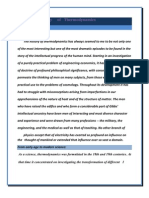In The History of Science
In The History of Science
Uploaded by
Jaspreet SinghCopyright:
Available Formats
In The History of Science
In The History of Science
Uploaded by
Jaspreet SinghOriginal Description:
Original Title
Copyright
Available Formats
Share this document
Did you find this document useful?
Is this content inappropriate?
Copyright:
Available Formats
In The History of Science
In The History of Science
Uploaded by
Jaspreet SinghCopyright:
Available Formats
In the history of science, the theory of heat or mechanical theory of heat was a theory,
introduced in 1798 by Sir Benjamin Thompson, better known as Count Rumford and developed
more thoroughly in 1824 by the French physicist Sadi Carnot, that heat and mechanical work are
equivalent.
[1]
[2]
It is related to the mechanical equivalent of heat. Over the next century, with the
introduction of the second law of thermodynamics in 1850 by Rudolf Clausius, this theory
evolved into the science of thermodynamics. In 1851, in his "On the Dynamical Theory of Heat",
William Thomson outlined the view, as based on recent experiments by those such as James
Joule, that heat is not a substance, but a dynamical form of mechanical effect, we perceive that
there must be an equivalence between mechanical work and heat, as between cause and effect.
[3]
In the years to follow, the phrase the "dynamical theory of heat" slowly evolved into the new
science of thermodynamics. In 1876, for instance, American civil engineer Richard Sears
McCulloh, in his Treatise on the Mechanical Theory of Heat, stated that: the mechanical theory
of heat, sometimes called thermo-dynamics, is that branch of science which treats of the
phenomena of heat as effects of motion and position.
This term was used in the 19th century to describe a number of laws, relations, and experimental
phenomenon in relation to heat; those such as thermometry, calorimetry, combustion, specific
heat, and discussions as to the quantity of heat released or absorbed during the expansion or
compression of a gas, etc. One of the most famous publications, in this direction, was the
Scottish physicist James Clerk Maxwells 1871 book Theory of Heat, which introduced the
world to Maxwell's demon, among others.
[4]
Another famous paper, preceding this one, is the
1850 article On the Motive Power of Heat, and on the Laws which can be deduced from it for the
Theory of Heat by the German physicist and mathematician Rudolf Clausius in which the
concept of entropy began to take form.
[5]
The term theory of heat, being associated with either vibratory motion or energy, was
generally used in contrast to the caloric theory, which views heat as a fluid or a weightless gas
able to move in and out of pores in solids and found between atoms. However
You might also like
- Theory of Heat by The German Physicist and Mathematician: Citation NeededDocument1 pageTheory of Heat by The German Physicist and Mathematician: Citation NeededJaspreet SinghNo ratings yet
- Theory of HeatDocument2 pagesTheory of HeatImma ÁvalosNo ratings yet
- New Word 2007 DocumentDocument1 pageNew Word 2007 DocumentbhatiaharryjassiNo ratings yet
- ThermdynamcsDocument13 pagesThermdynamcsTejas krishnakanthNo ratings yet
- ThermodynamicsDocument15 pagesThermodynamicspsri1944No ratings yet
- Thermodynamics - WikipediaDocument15 pagesThermodynamics - Wikipediapsri1944No ratings yet
- ThermodynamicsDocument14 pagesThermodynamicsdanny222No ratings yet
- Thermodynamics - WikipediaDocument78 pagesThermodynamics - WikipediasubhajitparichhaNo ratings yet
- Thermodynamics - WikipediaDocument15 pagesThermodynamics - Wikipediapsri1944No ratings yet
- Chapter 1Document18 pagesChapter 1M Sigit A MaskarebetNo ratings yet
- Thermodynamics Is A Branch Of: (Hide)Document5 pagesThermodynamics Is A Branch Of: (Hide)ksrm123No ratings yet
- Thermodynamic SystemDocument9 pagesThermodynamic SystemJordan MosesNo ratings yet
- Notes PHY3Document3 pagesNotes PHY3Ako ToNo ratings yet
- Sejarah KalorDocument8 pagesSejarah KalorArif Eko SumaryantoNo ratings yet
- Thermodynamics 101 - 2Document2 pagesThermodynamics 101 - 2Joseph DustNo ratings yet
- 1.1 Preliminary Semantics: Read BS, Chapter 1Document18 pages1.1 Preliminary Semantics: Read BS, Chapter 1Palash KanjilalNo ratings yet
- Thermodynamics Is The Branch ofDocument2 pagesThermodynamics Is The Branch ofbennyNo ratings yet
- Timeline of ThermodynamicsDocument4 pagesTimeline of ThermodynamicsBob JoeNo ratings yet
- Thermodynamics: Thermodynamics Is A Branch ofDocument22 pagesThermodynamics: Thermodynamics Is A Branch ofPradeep KumarNo ratings yet
- Thermodynamics: Thermodynamics Is A Branch of Physics Concerned With Heat andDocument10 pagesThermodynamics: Thermodynamics Is A Branch of Physics Concerned With Heat andJayaNo ratings yet
- ThermodynamicsDocument14 pagesThermodynamicsEurich EstradaNo ratings yet
- Hermodynamics Is The Branch Of: System SurroundingsDocument8 pagesHermodynamics Is The Branch Of: System SurroundingsDamisha DamishaNo ratings yet
- Thermodynamics Assignment 1Document3 pagesThermodynamics Assignment 1Twinkle Anne RosalesNo ratings yet
- Thermodynamics Assignment 1Document2 pagesThermodynamics Assignment 1Twinkle Anne RosalesNo ratings yet
- History and Outlook of Statistical PhysicsDocument13 pagesHistory and Outlook of Statistical PhysicsWritobroto MukhopadhyayNo ratings yet
- History of Energy - WikipediaDocument18 pagesHistory of Energy - WikipediaAlam Surya InggilNo ratings yet
- History of ThemodynamicsDocument18 pagesHistory of Themodynamicsyasir_arafat_132182No ratings yet
- Thermodynamics Is The Study of The Relationships Between HeatDocument1 pageThermodynamics Is The Study of The Relationships Between HeataeiousNo ratings yet
- Team ThermalDocument11 pagesTeam ThermalDamisha DamishaNo ratings yet
- Units of Measure: EnergeiaDocument1 pageUnits of Measure: EnergeiaPaul GeorgeNo ratings yet
- ThermodynamicsDocument8 pagesThermodynamicsec0nomistNo ratings yet
- Van Der WaalsDocument93 pagesVan Der WaalsRandy Brandon Gallegos Rodríguez100% (1)
- James Prescott Joule Was An English PhysicistDocument2 pagesJames Prescott Joule Was An English PhysicistXdNo ratings yet
- A Thermodynamics HistoryDocument8 pagesA Thermodynamics HistoryJaster Monloise Baña SanicoNo ratings yet
- Thermal EnergyDocument4 pagesThermal Energynordiea miller-youngeNo ratings yet
- Chinese 142 JournalDocument4 pagesChinese 142 JournalMaye RecierdoNo ratings yet
- Physics 2Document1 pagePhysics 2AlbertJnBaptisteNo ratings yet
- Heat NotesDocument2 pagesHeat NotesCodebreaker5No ratings yet
- Thermodynamics Is The Science Of: o o o o oDocument15 pagesThermodynamics Is The Science Of: o o o o oPratik YadavNo ratings yet
- Rudolf ClausiusDocument2 pagesRudolf ClausiusAndruşa IoanaNo ratings yet
- AcTeJa 2010 1 BozsakyDocument16 pagesAcTeJa 2010 1 BozsakyDavid PérezNo ratings yet
- Physical Chemistry Chemical Engineering Mechanical Engineering Joseph Black Carnot Napoleonic Wars Lord KelvinDocument1 pagePhysical Chemistry Chemical Engineering Mechanical Engineering Joseph Black Carnot Napoleonic Wars Lord Kelvinmarina890416No ratings yet
- Atomism Leucippus Democritus Epicureans Atomic Theory AtomsDocument7 pagesAtomism Leucippus Democritus Epicureans Atomic Theory Atomsjaivishnu007No ratings yet
- Historical Observations On Laws of Thermodynamics: Stanley I. Sandler and Leslie V. WoodcockDocument6 pagesHistorical Observations On Laws of Thermodynamics: Stanley I. Sandler and Leslie V. WoodcockNatNo ratings yet
- Laws of ThermodynamicsDocument5 pagesLaws of ThermodynamicsRobert OnsareNo ratings yet
- Heat, Temperature, Entropy: Alexander I. Melker, Sergey A. Starovoitov and Tatiana V. VorobyevaDocument16 pagesHeat, Temperature, Entropy: Alexander I. Melker, Sergey A. Starovoitov and Tatiana V. VorobyevaDandi AlfiandiNo ratings yet
- ThermoDocument1 pageThermoJuan RosalesNo ratings yet
- The Conceptual Import of Carnots TheoremDocument27 pagesThe Conceptual Import of Carnots Theoremarun rajaramNo ratings yet
- ScienceDocument2 pagesScienceUma VijayNo ratings yet
- Thermodynamics: From Wikipedia, The Free EncyclopediaDocument8 pagesThermodynamics: From Wikipedia, The Free Encyclopediaeaglebaby11No ratings yet
- Introduction, History and Applications: Engr. Shakeel AhmadDocument13 pagesIntroduction, History and Applications: Engr. Shakeel AhmadShakeel MohmandNo ratings yet
- History of ThermodynamicsDocument14 pagesHistory of Thermodynamicsattan5tsuiNo ratings yet
- KRAGH, Helge - Julius Thomsen and Classical ThermochemistryDocument19 pagesKRAGH, Helge - Julius Thomsen and Classical ThermochemistryCarlo FuentesNo ratings yet
- Max Planck and The Genesis of The Energy Quanta inDocument6 pagesMax Planck and The Genesis of The Energy Quanta inCatalin MeiuNo ratings yet
- ThermodynamicsDocument1 pageThermodynamicsKevin Walf H. AñonuevoNo ratings yet
- Conservation of Energy - WikipediaDocument80 pagesConservation of Energy - WikipediaAlam Surya InggilNo ratings yet
- TQM in ToyotaDocument7 pagesTQM in ToyotaJaspreet SinghNo ratings yet
- Synopsis HR Policies Aachi MasalaDocument14 pagesSynopsis HR Policies Aachi MasalaJaspreet Singh33% (3)
- Full Final Absentism HyundaiDocument89 pagesFull Final Absentism HyundaiJaspreet SinghNo ratings yet
- Absenteeism at HyundaiDocument58 pagesAbsenteeism at HyundaiJaspreet SinghNo ratings yet
- Syn of Quality of Life at EastmanDocument16 pagesSyn of Quality of Life at EastmanJaspreet SinghNo ratings yet
- Nabard Working CapitalDocument12 pagesNabard Working CapitalJaspreet SinghNo ratings yet
- Nutritional Assessment and Its Comparison Between Obese and NonDocument37 pagesNutritional Assessment and Its Comparison Between Obese and NonJaspreet SinghNo ratings yet


































































